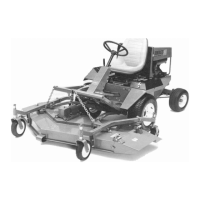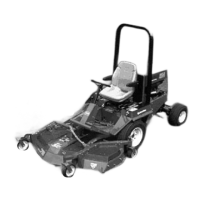Groundsmaster 3500 Page 6 - 17 Electrical System
Diode Assemblies
Groundsmaster 3500 machines use diodes that plug
into the wiring harness (Fig. 16). Location of the diodes
is under the control console.
DiodeD1isusedonbothdieselandgasolinepowered
units. Diode D1 is used to protect the PTO solenoid
valve coil from reverse polarity.
Diodes D2 and D3 are used on gasoline powered units
only.DiodeD2isusedtoprotectthecircuitsfromvoltage
spikes when the engine starter solenoid is de- ener-
gized. Diode D3 protects the engine start relay circuit
from reverse polarity.
The diode assemblies can be identified by a black color
and a diode symbol on the end of the diode assembly
body. Refer to the engine wire harness drawing in Chap-
ter 9 in this manual for additional information on diode
assembly location.
Testing
The diodes can be individually tested using a digital
multimeter (diode test or ohms setting) and the table be-
low.
Multimeter
RedLead(+)
on Terminal
Multimeter
Black Lead (- )
on Terminal
Continuity
Female Male YES
Male Female NO
1. Diode
2. Male terminal
3. Female terminal
4. End of diode body
1
2
3
4
Figure 16
CAN- bus Termination Resistor (Gasoline Engines Only)
System communication between electrical components
on Groundsmaster 3500- G machines is accomplished
on a CAN- bus communication system. Two (2) special-
ly designed, twisted cables form the bus for the network
used on the machine. These wires provide the data
pathways between machine components. At the end of
one of the cables is a 120 ohm termination resistor.
The CAN- bus termination resistor plugs into the main
wire harness under the operator’s control panel (see
Chapter 9 - Foldout Drawings in this manual). The res-
istor can be accessed by removing the control panel
cover. The termination resistor and the wire harness
connector have blue inserts to identify the proper loca-
tion for the termination resistor. The resistor also has a
center keyway to prevent it from plugging into the wrong
wire harness connector.
IMPORTANT: The termination resistor i s required
for proper electrical system operation.
Termination Resistor Test
Remove the termination r esistor from the main wire har-
ness (Fig. 17). Test the resistor using a digital multimeter
(ohms setting). There should be 120 ohms resistance
across terminals A and B of the termination resistor.
Figure 17
Termination
Resistor
A
B
C
Keyway
Electrical
System

